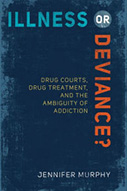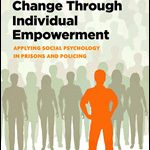ILLNESS OR DEVIANCE: DRUG COURTS, DRUG TREATMENT, AND THE AMBIGUITY OF ADDICTION

Author: Jennifer Murphy
Publisher: Philadelphia: Temple University Press, 2015. 221p.
Reviewer: Tracy Lightcap | January 2017
Somewhere Erving Goffman is smiling.
Goffman was a sociologist who is most famous for his concept of “image management,” i.e., the way we all try to construct the way we appear to others in order to suit both our environments and the people we encounter within them. As Jennifer Murphy’s new book on drug courts shows, this is still an extremely useful way to approach the analysis of any social situation, especially when the actions we take are constrained by institutional goals that individuals are required to meet. Many of the puzzles of behavior by defendants in drug courts, as well as the program staff members and the legal communities in which they operate are, if not solved, at least illuminated by this informative and interesting book. But we are getting a little ahead of ourselves. If we can get a better idea of just what those puzzles are, we can begin to assess Murphy’s examination of them.
Drug courts are a subset of a broader movement that applies therapeutic methods to people convicted of criminal activities. There are a variety of new courts ̶ specializing in, for example, mental health, family treatment, drunk driving and other social problems ̶ that attempt to apply an ostensible medical model for defining and treating the “root causes” of criminal behavior within the adjudicative process required by the laws. This development has been spurred by two separate but connected considerations: (1) continuing and chronic recidivism among certain classes of offenders; and (2) increasing evidence that traditional models for addressing criminal behavior by incarceration and fines have not been working as intended for many offenses. The combination of high costs to the legal system for adjudicating public order offenses, and the need for alternative sanctions has led to new judicial remedies, most of them based on the already existing juvenile court model, but modified to include treatment for what have increasingly been seen as underlying medical conditions. The first drug court, put together by Janet Reno in 1989 when she was the prosecutor in Dade County, FL, was the precursor of almost 2,500 such courts in operation today. (Ms. Reno later became the first woman to be U.S. Attorney General, serving in the administration of President Bill Clinton.)
But the increasing scope and number of therapeutic courts have not solved the analytical dilemmas involved in studying and evaluating them. Like many others, I have found the basic goals of drug courts to be hard to unravel theoretically, at least in part because of the conflicting methods and ideas that they force together. However, as Murphy points out, the confusion many people face in trying to figure out what drug courts are actually doing is what needs to be explained. The way drug courts operate reflects a basic ambiguity in thinking about addiction; i.e., is addiction a medical problem to be approached therapeutically or a legal problem that appropriately results in criminal sanctions? The solution adopted by those who work in drug court administration and treatment has been to classify their “clients” (legally, criminal probationers, but I will use this description in the rest of this review) as victims of addiction, which is viewed as a chronic medical condition that must be addressed to prevent further offenses. The difficulty for the clients, of course, is that their treatment and the definition of their behavior problem is shaped and constrained more by legal sanctions than by medical considerations. The elucidation of the consequences of these conflicts and the image management they entail is what Murphy’s book is about.
After a useful chapter orienting readers to the history of U.S. drug policy and the institutional twists and turns leading to the use of drug courts, Murphy turns to a consideration of the legal side of the equation. Here the ambiguities she examines are acute. The initial determination of who should be accepted into the particular urban drug court she examined was made by court personnel and staff. This is where “image management” became all-important. Despite generally accepting a medical view of addiction, the court staff members interviewed by Murphy were not using a medical description of the defendants’ condition. Instead, from the judge of the court on down, they defined the condition that led to the clients’ legal problems as “drug abuse.” This was a generalization that was not limited to drug use alone, but often included drug sales as well. The court staff saw themselves as disrupting a client “lifestyle” centered around drugs. Hence, the staff members’ emphasis was on changing the clients’ lives.: Success in the program was measured according to how faithfully the clients followed court orders, attended monthly court sessions where their performance was rewarded or sanctioned, participated in treatment programs, gained employment, furthered their education, and successfully avoided further drug use. The problem for the clients was difficult and the stakes were high — how could they convince the court that they had a sincere enough dedication to changing their lives that they should be admitted to the drug court program rather than be sent to prison? The court staff members tried to predict if the client would show sufficient “responsibility” to benefit from a “second chance,” and then they rigorously enforced the terms of the drug court program for those clients who did so.
Clients admitted to the drug court’s treatment programs faced further challenges of image management. Here Murphy’s attention to research design pays off; the programs used by the drug court she selected tracked clients into two separate treatment models, and the comparison between them is analytically useful. The two tracks were based, respectively, on a) intensive group therapy or b) methadone “maintenance,”: but, as Murphy shows, they tended to use similar therapeutic ideas. This was due to the same ambiguities found at the initial commitment decision. First, there were no federal and precious few state standards for certifying drug counselors. Most of the treatment personnel Murphy monitored had no professional training in the field. While all staff members accepted the definition of addiction as a chronic disease, there was no general agreement among them about what caused it or how to treat it. (However, “Twelve Step” programs aimed at abstinence were generally accepted by staff members.) The result was a hodgepodge of treatment methods as staff members based their choices on their own prior work experiences. Second, the two tracks were evaluated differently. It is admitted generally now that opiate addiction is best handled through maintenance programs. The treatment staff, however, thought that those on maintenance doses were “failures” who lacked sufficient responsibility to reject their “drug lifestyle.” This perspective justified using staff control of maintenance dosages as a means of sanctioning offender misbehavior. That most of the maintenance clients were referred by the court (the group therapy track had many self-referred patients) reinforced this division. Finally, there were the status differences between the treatment staff and the clients. Most of the staff looked on their work as a temporary career detour; even the supervisors had bigger plans. This was the result of both their higher educational attainments and their reaction to the clients and their surroundings. A combination of class and status differences ̶ and the staff members’ already jaded attitudes toward the clients ̶ resulted in staff members’ impatience with client “failure,” distrust of the clients, and willingness to use the legal system to enforce treatment parameters.
One can imagine where all this left the clients. At each stage in the drug court process they found themselves between the “rock” of jail and the “hard place” of presenting themselves as “responsible.” Much of Murphy’s book is concerned with the difficulties this presents. Consider those clients who were not actual drug users. The intensive therapy track had many of these defendants, who had avoided prison by admitting that they were caught in a “drug lifestyle” and needed treatment to “get back on their feet.” Murphy presents telling evidence of how these clients and more casual drug users advised one another about how to present themselves to treatment staff. Indeed, the groups themselves enforced behavior that was geared specifically to meeting program goals. For example, one way to ensure that you would avoid getting back before the judge was by showing your commitment to treatment by encouraging others to reform themselves. The hardest path was reserved for those in the maintenance track. Methadone was only available at set times, as were the program’s group therapy sessions. These times often conflicted with clients’ work or school hours. Client complaints about this were usually shrugged off by treatment staff as showing a lack of commitment to program goals. The predictable “failures” looped the clients back to court.
Murphy did not write this book to condemn the confusions she found — her brief is to describe them. Her aim is to give the reader a better idea of the strengths and weaknesses of an increasingly popular institutional innovation. This is a useful endeavor; the paradox is that, while the drug courts can make life difficult for their clients, they often succeed in reducing recidivism and rebuilding lives dislocated by drug use. In her conclusion, she uses her findings to make recommendations for more efficient and humane treatment within the courts. Specifically, she calls for better funded and more professional programs, more diverse programs for treating drug abuse and a much stricter definition of that term, and reducing the stigma of drug use by reducing the legal and employment restrictions on drug users. No doubt these changes would help, but what are we to make of her analysis and of these conclusions?
Somewhere, Michel Foucault, with a skeptical Gallic smile, is shaking his head.
All through my reading of Murphy’s interesting and informative book, I was waiting for the other shoe to drop. Foucault’s oft-quoted assessment of criminology as a discourse kept coming to mind: “One has the impression that it [drug courts in this case] is of such utility, is needed so urgently and rendered so vital for the working of the system, that it does not even need to seek a theoretical justification for itself, or even simply a coherent framework. It is entirely utilitarian (Foucault 1980, p. 37).” This is, I think, a good short description of the drug court Murphy examines and why the ambiguities and subsequent confusions she spotlights have come about. The usual next step would be to examine the power relationships that sustain the drug court model and to try to get a bit deeper into who benefits from them and why. (The phrase “crony capitalism” kept coming to mind as I read.) That in turn would tell us a lot about the resistance (for that is what it is) of the clients to drug court procedures, what their true motivations are, and what the courts are actually accomplishing. Description of the ways that legal and treatment staff members control their clients’ lives could benefit from such a perspective as well. Finally, it would also illuminate the ways that those in power might evaluate and (almost certainly) distort or dismiss the policy recommendations Murphy offers in her conclusions.
But perhaps I should stop criticizing Murphy for the book she did not write and get around to evaluating the one she did. Despite my minor reservations, this book is a most worthwhile read. Usually, those interested in drug courts look at the results — they do help people a lot more than jail does — and do not inquire too deeply into how they work. Murphy’s study provides the first realistic and critical look at how and why drug courts attempt to manipulate their clients, how clients adjust to these efforts, and what difficulties and confusions this leads to. In the process, she has created an analytical path for future studies of drug courts and laid the groundwork for more realistic evaluation of them. With any kind of luck, other researchers (or perhaps Murphy herself) will attempt to validate her findings with either additional qualitative studies or by working up quantitative studies with larger samples of clients. It is high time this happened; most of the research to date has tried to evaluate the results of drug court interventions within the perspective of the courts themselves. The result has been the self-congratulatory echo chamber that Murphy has now exploded. Let us hope that her efforts will inspire more and better studies in future. Both drug courts as institutions and the clients they seek to help would benefit from that.
Foucault, Michel. 1980. Power/Knowledge: Selected Interviews and Other Writings, 1972 – 1977. Edited by Colin Gordon. New York: Pantheon.
Tracy Lightcap, Professor, Department of Political Science, LaGrange College.


